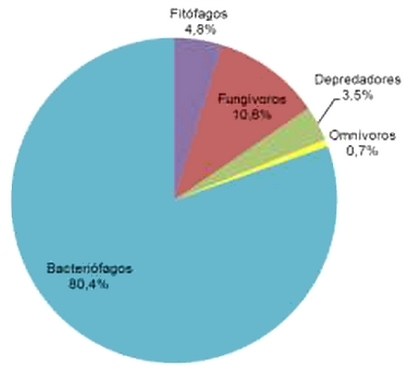Biofumigación con Mostaza parda (Brassica juncea L. Czern.). Efecto sobre la Nematofauna del Suelo.
El objetivo de este trabajo fue evaluar el efecto de la biofumigación con mostaza parda (mp), sobre la nematofauna de un suelo. Los tratamientos fueron: cobertura de suelo con polietileno negro (M), abonado (incorporación de 2 kg.m-2 de mp) (A) y biofumigación (B=A+M). Se contrastó con un control sin abonado ni cobertura (C). En A y B se sembró mp y cuando alcanzó el estadio de fin de fructificación, se trituró e incorporó al suelo. En M y B se cubrió el suelo con polietileno negro durante 21 días. Se identificaron y cuantificaron los grupos tróficos de la nematofauna. En B y A, la densidad de nematodos de vida libre (NVL) se incrementó 344% y 552%, respectivamente, observándose diferencias significativas con M y C, debidas principalmente a aumentos en las densidades de bacteriófagos y, en menor medida, de fungívoros. No se observaron diferencias significativas entre tratamientos en la densidad de NPP. La biofumigación con 2 kg.m-2 de mp incrementó la densidad de NVL, por lo que sería compatible con estos organismos benéficos del suelo.
Palabras claves: control biológico; nemátodos; manejo integrado de plagas; mostaza parda.
Abstract
The aim of this work was to evaluate the effect of biofumigation with brown mustard (mp) on soil nematofauna. The treatments were: soil cover with black polyethylene (M), green manure (incorporation of 2 kg.m-2 of mp) (A) and biofumigation (B = A + M). It was contrasted to a control without green manure or soil cover (C). In A and B, mp was sown and when it reached the end of fruiting stage, triturated and incorporated into the soil. In M and B the soil was covered with black polyethylene for 21 days. The trophic groups of nematofauna were identified and quantified. In B and A, the density of free-living nematodes (NVL) increased 344% and 552%, respectively, showing significant differences with M and C, mainly due to increases in the densities of bacteriophages and, to a lesser extent, of fungivores. No significant difference between treatments in the density of phytophagous was observed. The biofumigation with 2 kg.m-2 of mp increased the density of NVL, so it would be compatible with these beneficial soil organisms.
Keywords: biological control; nematodes; integrated pest management; brown mustard.
1er Congreso Argentino de Agroecología. Facultad de Ciencias Agrarias de la Universidad nacional de cuyo. Área temática: 2- Diseño y manejo de los agroecosistemas de base agroecológica. Sub tema: Estrategias para la evaluación, diseño y manejo de la biodiversidad; para el manejo de plagas y enfermedades; para el manejo del suelo en sistemas agroecológicos.
Los suelos infestados de nematodos parásitos de plantas (NPP) son una de las principales problemáticas fitosanitarias en el Cinturón Hortícola de La Plata (CHLP). La especie más perjudicial en esta zona es Nacobbus aberrans (Thorne 1934), Thorne & Allen 1944, que infecta y produce importantes pérdidas de rendimientos en los cultivos de mayor importancia económica bajo cubierta. En el CHLP, el manejo de los NPP suele realizarse con fumigantes de suelo sintéticos, que presentan el inconveniente de ser tóxicos para el aplicador y contaminantes del medio ambiente. Por estos motivos, es importante sustituir los fumigantes sintéticos por otras alternativas enmarcadas en un manejo agroecológico de esta plaga. Una de esas alternativas es la biofumigación con brassicáceas, que ha demostrado ser eficaz para reducir poblaciones de NPP (5, 7, 8, 9, 12).
La biofumigación con brassicáceas consiste en la incorporación en el suelo de materiales orgánicos proveniente de ciertas especies de esa familia botánica, que liberan durante su descomposición, sustancias con actividad biocida (6). Entre las especies de brassicáceas más estudiadas como biofumigantes se encuentra la mostaza parda (mp) (Brassica juncea L. Czern). A diferencia de los fumigantes de suelo sintéticos, como el metam sodio y el dazomet, la incorporación de enmiendas biofumigantes mejora la estructura y aumenta el contenido de materia orgánica del suelo, incrementa la penetración del agua y reduce el encostramiento (11).
Desde el punto de vista productivo, resulta importante ampliar los conocimientos en el área de la biofumigación para el manejo de NPP, pero también es fundamental para la estabilidad del agroecosistema, conocer los efectos de esta práctica sobre los nematodos benéficos o de vida libre (NVL). Los NVL pueden ser agrupados en cuatro grupos tróficos bien diferentes entre sí: fungívoros, bacteriófagos, depredadores y omnívoros (14); aportan al ecosistema edáfico diversos servicios ecosistémicos, como la mineralización y redistribución de nutrientes, al alimentarse de bacterias y hongos que descomponen la materia orgánica del suelo y la supresión de organismos plaga.
El objetivo de este trabajo fue evaluar el efecto de la biofumigación con mp, sobre la nematofauna presente en el suelo de un invernáculo, en el CHLP.
Metodología
El ensayo se realizó un invernáculo de la Chacra Experimental Integrada Gorina (MAIBAINTA), ubicada dentro del CHLP, La Plata, Argentina (34°55’ S, 58°02’ O), desde el 2 junio al 21 de noviembre del año 2018. El material vegetal utilizado para incorporar al suelo fue una variedad de mostaza parda (Brassica juncea L. Czern.), obtenida en el Instituto Fitotécnico de Santa Catalina, UNLP.
Los tratamientos evaluados fueron: el uso de mulching con polietileno negro (M), la práctica de abonado (incorporación de mostaza al suelo) (A) y la biofumigación con mostaza (incorporación de mostaza + mulching de polietileno negro) (B). Los tratamientos fueron comparados con un control (C) para el cual no se utilizó mulching, ni se incorporó mostaza.
La unidad experimental consistió en un lomo de 0,60 m de ancho y 8,5 m de largo. A fines de junio se labró el suelo con motocultivador y se armaron los lomos para todos los tratamientos. En A y B se sembró la mostaza, a razón de 12 kg.ha-1 y en M y C no se realizó ninguna práctica. Todos los tratamientos se mantuvieron desmalezados y fueron regados con la misma cantidad de agua. Cuando el cultivo de mostaza alcanzó el estadio de fin de fructificación, a fines de octubre, se arrancaron las plantas de raíz, se armaron andanas e inmediatamente se trituraron con cortadora de césped y se incorporaron al suelo con un motocultivador, en dosis de 2 kg.m-2 de material fresco. Simultáneamente, se roturó el suelo en M y C con un motocultivador, pero no se incorporó mostaza. Posteriormente se regaron todas las parcelas a capacidad de campo y los tratamientos M y B se cubrieron con polietileno negro. Transcurridos 21 días, se retiró el mulching. Se realizaron tomas de muestras de suelo en tres momentos: previo a la siembra de la mostaza (F1), al momento de la incorporación de la biomasa (F2) y 21 días después de la incorporación (F3). Cada muestra de suelo se mezcló homogéneamente, se separó una alícuota de 100 cm3 y se la procesó (2, 4). Se realizó una identificación y recuento de los distintos grupos tróficos de la nematofauna presente. En el caso de los NPP y fungívoros se empleó la clave de Chaves et al. (1995) para determinarlos a nivel género. Se utilizó un diseño experimental completamente aleatorizado con cuatro repeticiones por tratamiento. Se practicó ANOVA simple y las medias se compararon mediante la prueba de Tukey. Se utilizó el programa Statistica 7.
Resultados y Discusión
Al inicio del ensayo (F1), los NVL representaron el 95,2% de la abundancia total, con una densidad de 127 ± 15,6 individuos en 100 cm3 de suelo (ind./100 cm3) (Fig. 1). Los bacteriófagos fueron el grupo trófico dominante, con una densidad de 107,3 ± 14,5 ind./100 cm3, seguido en abundancia por los fungívoros con 14,1 ± 2,4 ind./100 cm3. Los fungívoros que predominaron en el invernáculo fueron Psilenchus, Tylenchus y Aphelenchus. Los dos primeros géneros son difíciles de agrupar ya que presentan especies tanto fitófagas como fungívoras. En los lotes ensayados, Psilenchus y Tylenchus mostraron un comportamiento contrario al de los NPP, aumentando sus poblaciones sin hospedantes vegetales a los cuales infectar. Por esta razón y por el tipo de estiletes débiles o delicados que poseían, se tomó la decisión de agruparlos como fungívoros. La densidad de nemátodos depredadores y omnívoros fue 4,7 ± 1,6 y 0,9 ± 0,2 ind./100 cm3, respectivamente. Los NPP representaron el 4,8% de la abundancia total, con 6,4 ± 1, ind./100 cm3 (Fig. 1). Los representantes de cada grupo trófico se detallan en la Tabla 1.
Tabla 1: Grupos tróficos de nematodos encontrados durante el desarrollo del ensayo. NPP: nematodos parásitos de plantas; NVL: nematodos de vida libre.


En M y C, la densidad de nemátodos de todos los grupos tróficos presentó escasa variación en los tres muestreos realizados, sin observarse diferencias significativas entre las fechas.
En B, la densidad de NVL se incrementó 289% y 344% en F2 y F3, respectivamente. En A, la densidad de NVL se incrementó 30% y 552% en F2 y F3, respectivamente. Los incrementos de los NVL observados en A y B, fueron debidos principalmente a aumentos en las densidades de bacteriófagos y, en mucha menor medida, del grupo fungívoro. La incorporación de mp en el suelo no afectó la abundancia de nemátodos depredadores, omnívoros y NPP.
Dentro del grupo NPP, al inicio del ensayo, se identificó el género Helicotylenchus, con una densidad de 3,8 ind./100 cm3, presente en el 63% de las muestras y la especie Nacobbus aberrans, con una densidad de 2,7 ind./100 cm3, presente en el 50% de las muestras. En las tres fechas de muestreo no se observaron diferencias significativas entre tratamientos en la densidad de NPP. Cabe destacar, que las condiciones del suelo del invernáculo empleado, corresponden a las de un suelo sano. Esto se evidencia por la alta proporción de los cuatro grupos tróficos de NVL y por la baja densidad de NPP, en especial con respecto a lo parásitos sedentarios como Nacobbus aberrans (Fig. 1).
Las poblaciones de bacteriófagos en las fechas de muestreo F1 y F2 no mostraron diferencias significativas entre tratamientos. En F3, los tratamientos A y B difirieron significativamente de M y C (p value ≤ 9,73 x 10-3) en la densidad de bacteriófagos. No se registraron diferencias significativas entre A y B, ni entre M y C.
En las tres fechas de muestreo no se observaron diferencias significativas entre tratamientos en la densidad de nemátodos fungívoros, sin embargo, en los tratamientos A y B se observaron incrementos en la densidad de este grupo trófico para la F3. En las tres fechas de muestreo no se observaron diferencias significativas entre tratamientos en la densidad de nemátodos depredadores y omnívoros.
En F1 y F2 no se observaron diferencias significativas entre tratamientos en la densidad del grupo NVL. En F3 los tratamientos A y B presentaron mayor abundancia y difirieron significativamente de M y C (p value ≤ 1,86 x 10-2). No se registraron diferencias significativas entre los tratamientos A y B, ni entre M y C.
La incorporación de mp en el suelo incrementó la cantidad de NVL con respecto al control, inclusive en el tratamiento biofumigación, donde la cobertura del suelo con polietileno favorece una mayor concentración de isotiocianatos biocidas (10). Esos incrementos fueron debidos principalmente, al aumento de la densidad del grupo bacteriófago, y en menor medida, del grupo fungívoro. Los bacteriófagos son organismos de ciclo corto y sus poblaciones crecen rápidamente ante la disponibilidad de alimento. En los ambientes donde existe una importante actividad bacteriana, por la descomposición de materia orgánica, las poblaciones de bacteriófagos crecen. Nuestros resultados coinciden con los hallados por
Rodríguez et al. (2018), que observaron incremento de la abundancia de bacteriófagos como resultado de la incorporación en el suelo de residuos de cosecha de repollo (Brassica oleracea L. var. capitata) en dosis de 5 kg.m-2, sin cobertura de polietileno. Asimismo, Bongiorno et al. (2009) encontraron que la biofumigación con distintas brassicáceas tuvo un efecto positivo sobre los NVL, contribuyendo al restablecimiento de las cadenas tróficas y al aumento de la biodiversidad funcional.
Conclusiones
Bajo las condiciones de este ensayo, la biofumigación con 2 kg.m-2 de mostaza parda, en el estadio de fin de fructificación, incrementa la densidad de NVL, especialmente del grupo bacteriófago, por lo que sería compatible con estos organismos benéficos del suelo. La biofumigación no modificó la densidad de NPP, que en este ensayo fue inicialmente muy baja; por ello no fue posible evaluar el efecto biocida sobre este grupo. La biofumigación con mostaza parda podría ser una práctica recomendable en los agroecosistemas hortícolas.
1Chacra Experimental Integrada Gorina, MAIBA-INTA. La Plata, Buenos Aires, Argentina; 2Universidad Nacional de La Plata. La Plata, Buenos Aires, Argentina; 3Instituto Fitotécnico de Santa Catalina, Facultad de Ciencias Agrarias y Forestales, UNLP. Llavallol, Buenos Aires, Argentina; 4Facultad de Ciencias Agrarias, Universidad Nacional de Lomas de Zamora. Llavallol, Buenos Aires, Argentina; 5CEPAVE, CONICET-UNLP. La Plata, Buenos Aires, Argentina
1. Bongiorno, M.; Larrosa, C.; Maidana, A.; Arenas, M.; Cruz, Y.; López, R.; Gianuzzi, L.; Cap, G. B. 2009. Biofumigación con recursos locales: el caso de la producción hortícola de los quinteros del Parque Pereyra Iraola. LEISA Revista de Agroecología. 25 (4): 25-28.
2. Caveness, F. E.; Jensen, H. J. 1955. Modification of the centrifugal-flotation technique for the isolation and concentration of nematodes and their eggs from soil and plant tissue. In Proceedings of the Helminthological Society of Washington. Washington, Estados Unidos. 22 (2): 87-89.
3. Chaves, E. J.; Echeverría, M. M.; Torres, M. S. 1995. Claves para determinar géneros de nematodes del suelo de la República Argentina. Mar del Plata. Ed. Universidad Nacional de Mar del Plata. 91 p.
4. Doucet, M. E. 1980. Técnicas básicas en nematología del suelo. IDIA. 387/388: 34-43.
5. Edwards, S.; Ploeg, A. 2014. Evaluation of 31 Potential biofumigant Brassicaceous plants as hosts for three Meloidogyne Species. Journal of Nematology. 46: 287-295.
6. Kirkegaard, J. A.; Gardner, P. A.; Desmarchelier, J. M.; Angus, J. F. 1993. Biofumigation using Brassica species to control pests and diseases in horticulture and agriculture. In Proceedings of the 9th Australian Research Assembly on Brassicas. Wagga Wagga, Australia. Edited by Horsham, Vic. 77-82.
7. Kruger, N.; Fourie, J.; Malan, A. 2011. The role of cover crops in suppressing plant-parasitic nematodes in vineyards. In Proceedings of Biofumigation & Biopesticides Symposium. Saskatoon, Canadá. 63.
8. Lord, J. S.; Lazzeri, L.; Atkinson, H. J.; Urwin, P. E. 2011. Biofumigation for Control of Pale Potato Cyst Nematodes: Activity of Brassica Leaf Extracts and Green Manures on Globodera pallida in Vitro and in Soil. Journal of Agricultural and Food Chemistry. 59 (14): 7882-7890.
9. Masheva, S.; Yankova, V.; Toskov, G. 2012. Plant species screening for biofumigant activity against soil-borne pathogens and root-knot nematodes. Agricultural Science and Technology. 4: 139-142.
10. Price, A. J.; Charron, C. S.; Saxton, A. M.; Sams, C. E. 2005. Allyl Isothiocyanate and Carbon Dioxide Produced during Degradation of Brassica juncea Tissue in Different Soil Conditions. HortScience 40 (6): 1734-1739.
11. Pung, H.; Cross, S.; Patten, D. 2008. The use of biofumigant green manure crops for soil-borne disease management in Tasmania. In Proceedings of the Third International Biofumigation Symposium. Canberra, Australia. 26.
12. Riga, E. 2011. The effects of Brassica green manures on plant parasitic and free living nematodes used in combination with reduced rates of synthetic nematicides. Journal of nematology. 43 (2): 119-121.
13. Rodríguez, A. S.; Kees, E.; Azpilicueta, C. V.; Reybet, G. E. 2018. Evaluación del agregado de enmiendas orgánicas de origen animal y vegetal sobre la comunidad de nematodos del suelo. Actas V Congreso Nacional de Ecología y Biología de Suelos. Luján, Argentina. Ed. Universidad Nacional de Luján. 168-176.
14. Yeates, G. W.; Bongers, T. D.; De Goede, R. G. M.; Freckman, D. W.; Georgieva, S. S. 1993. Feeding habits in soil nematode families and genera-an outline for soil ecologists. Journal of nematology. 25 (3): 315.












